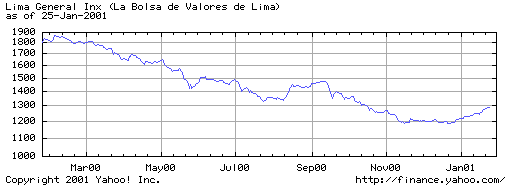A Global Market View
The outlook across the overseas stock markets, while still long-term bearish, shows considerable improvement in recent months, with several countries offering great short- to intermediate-term profit opportunities. This assessment of the foreign stock market outlook confirms our projection for the U.S. market in 2001, namely, that the market will proceed along an overall upward trajectory and will serve largely as a bear market rally year before the next leg down in 2002.
Notwithstanding the myriad trouble spots across the globe in the way of political, social and economic-related crises, there exist quite a few bright spots (short-term) that offer tremendous profit potential for traders. Most of them are in Asia, though some are in Europe and South America.
There is an old saying among investors that the time to buy stocks in a given country is when there is "blood running in the streets." That maxim certainly would apply to the recent developments in the Philippines. Amidst swirling news of a government collapse and the impeachment of the country's president, the Philippines have been a focal point for news commentators the past several days. According to recent headlines in the financial press, the country's stock market and currency (the peso) both "plunged" on the news of President Estrada's impeachment trial and civil unrest throughout the country. But the night is always darkest just before dawn, and the fact is that the Philippine financial sector is on the threshold of a turnaround.
The chart of the country's stock index, the PHS Composite, shows a splendid head and shoulders/rounding bottom reversal pattern that is the epitome of accumulation. Clear and perspicuous is the message of the market, and the verdict is one of healthy optimism rather then bleak pessimism. The PHS Composite is going higher in the weeks and months ahead and will return a hefty sum to far-sighted investors who were able to see through the political turmoil of recent months. The country represents a buy.
This same clear-cut accumulation pattern and bottom reversal can be seen in a number of Asian stock indexes, most notably the Thailand Set and the Taiwan Weighted, and to a lesser degree in the South Korean KOSPI. Each of these countries shares a bright intermediate-term outlook.
While the chart pattern of the Indonesian Jakarta Stock Exchange JSX Index is less impressive in terms of its upside potential, its pattern is nevertheless positive. The dominant short-term and intermediate-term cycles governing this index have both bottomed, and the priceline should see an overall upward trajectory through the first half of 2001. As of last month, a one-year line of supply was absorbed by demand, therefore the buyers should have control of this market.
The South and Central American stock markets are also showing signs of firming. Peru's Lima General Index displays one of the most textbook bowl-shaped accumulation pattern (short-term) we've ever seen. Chile's SASE Select index also looks strong as the priceline has just broken above the "neckline" of a head and shoulders bottom reversal. Viewed from a longer-term perspective, its chart shows a long narrow consolidation range that obviously represents accumulation since several successive lines of supply have already been broken. Based on the "Law of Vibration" (see our book Technical Analysis Simplified for details) the consolidation range in the Chilean stock market is projecting an upside objective of $140-$150 (from its current $104). From a time perspective this should be accomplished by no later than June. From a longer-term view, however, Chile remains in a bear market.

The European markets are a mixed lot but there are some promising short-term plays there as well. Germany's DAX index has likely seen a short-term bottom. So too has the Norwegian OSLO Total Index. The French CAC 40 Index has also bottomed short-term.
The chart that is most instructive from a U.S. standpoint is the London FTSE stock index. While a short-term bottom is in evidence in this index as well, the tremendous supply that has built up over the past two years has had a stifling influence on upside price momentum, even when the buyers are in control. From a long-term perspective, the FTSE, like its cousin the Dow, is under distribution. However, there will likely be enough manipulative buying and maneuvering to keep the index afloat for the better part of 2001. A breakout to new highs, however, is extremely unlikely and this same analysis applies to the Dow.
Closer to home, Canada's TSE 300—which many consider to be a leading indicator for the Dow—has broken above a four-month declining line of supply (trendline). On a short-term basis, it too has bottomed, and the line of least resistance in the near-term is up.
















